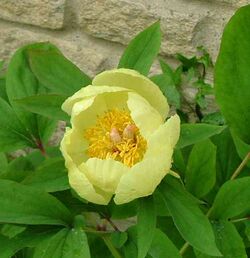Biology:Paeonia daurica subsp. mlokosewitschii
| Paeonia daurica subsp. mlokosewitschii | |
|---|---|

| |
| Scientific classification Error creating thumbnail: Unable to save thumbnail to destination
| |
| Kingdom: | Plantae |
| Clade: | Tracheophytes |
| Clade: | Angiosperms |
| Clade: | Eudicots |
| Order: | Saxifragales |
| Family: | Paeoniaceae |
| Genus: | Paeonia |
| Species: | |
| Subspecies: | P. d. subsp. mlokosewitschii
|
| Trinomial name | |
| Paeonia daurica subsp. mlokosewitschii (Lomakin) D.Y.Hong
| |
| Synonyms[1] | |
| |
Paeonia daurica subsp. mlokosewitschii, the golden peony or Caucasian peony, is a species of flowering plant native to the Caucasus Mountains in Azerbaijan, Georgia, and Dagestan, where it grows on rocky slopes in oak, hornbeam, or beech forests. The plant is sometimes nicknamed Molly the witch, a humorous mispronunciation of the species name, which most people find difficult to pronounce.[2] It was formerly regarded as a separate species, Paeonia mlokosewitschii, but in 2002, the Chinese botanist Hong Deyuan reduced it to a subspecies of Paeonia daurica.
Description
It is a herbaceous perennial plant growing 23–27 in (58–69 cm) tall, with biternate, glaucous leaves with obovate lobes. In spring it bears large, single, bowl-shaped lemon-yellow flowers 5 in (13 cm) in diameter, the ovary pubescent, the two to four carpels white, pink or yellow, and the stamen filaments yellow-green. In cultivation in the UK it has been given the Royal Horticultural Society's Award of Garden Merit.[3][4]
Taxonomy
Paeonia daurica subsp. mlokosewitschii was first described as a species, Paeonia mlokosewitchii, by Aleksandr Lomakin in 1897.[5] It was named after the Poland botanist Ludwik Młokosiewicz who first discovered it.[6] In 2002, the Chinese botanist Hong Deyuan reduced it to a subspecies of Paeonia daurica.[7][8]
References
- ↑ Hong, D.-Y. (2010), Peonies of the World, Kew Publishing and Missouri Botanical Garden, p. 176, ISBN 978-1-84246-392-5
- ↑ Pearson, Dan (6 May 2006). "Molly the Witch". Telegraph.com. https://www.telegraph.co.uk/gardening/3337738/Molly-the-witch.html.
- ↑ "RHS Plantfinder - Paeonia mlokosiewiczii". https://www.rhs.org.uk/Plants/12162/i-Paeonia-mlokosewitschii-i/Details.
- ↑ "AGM Plants - Ornamental". Royal Horticultural Society. July 2017. p. 71. https://www.rhs.org.uk/plants/pdfs/agm-lists/agm-ornamentals.pdf.
- ↑ "Plant Name Details for Paeonia mlokosewitchii Lomakin". The International Plant Names Index. http://www.ipni.org/ipni/idPlantNameSearch.do?id=711826-1.
- ↑ Coombes, Allen J. (1994). Dictionary of Plant Names. London: Hamlyn Books. ISBN 978-0-600-58187-1.. p. 134.
- ↑ "Paeonia daurica subsp. mlokosewitschii (Lomakin) D.Y.Hong". Plants of the World Online. Royal Botanic Gardens, Kew. https://powo.science.kew.org/taxon/urn:lsid:ipni.org:names:70029773-1.
- ↑ "Plant Name Details for Paeonia daurica Andrews subsp. mlokosewitschii (Lomakin) D.Y.Hong". The International Plant Names Index. http://www.ipni.org/ipni/idPlantNameSearch.do?id=711826-1.
External links
- Caucasian Representatives of the Genus Paeonia: 5. Paeonia mlokosewitschii
- Ornamental Plants From Russia: Paeonia mlokosewitschii
- Josef J. Halda and James W. Waddick. The Genus Paeonia. Timber Press. ISBN:0-88192-612-4
- A. Huxley [ed.] (1992). The New RHS Dictionary of Gardening 3: 438. Macmillan. ISBN:1-56159-001-0
- Paeonia — Pacific Bulb Society
- BBC Gardener's Question Time Factsheet (1 July 2001)
Wikidata ☰ {{{from}}} entry
 |

